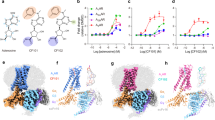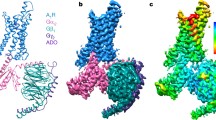Abstract
The G protein-coupled A2A adenosine receptor represents an important drug target. Crystal structures and modeling studies indicated that three disulfide bonds are formed between ECL1 and ECL2 (I, Cys712.69-Cys15945.43; II, Cys743.22-Cys14645.30, and III, Cys773.25-Cys16645.50). However, the A2BAR subtype appears to require only disulfide bond III for proper function. In this study, each of the three disulfide bonds in the A2AAR was disrupted by mutation of one of the cysteine residues to serine. The mutant receptors were stably expressed in Chinese hamster ovary cells and analyzed in cyclic adenosine monophosphate (cAMP) accumulation and radioligand binding studies using structurally diverse agonists: adenosine, NECA, CGS21680, and PSB-15826. Results were rationalized by molecular modeling. The observed effects were dependent on the investigated agonist. Loss of disulfide bond I led to a widening of the orthosteric binding pocket resulting in a strong reduction in the potency of adenosine, but not of NECA or 2-substituted nucleosides. Disruption of disulfide bond II led to a significant reduction in the agonists’ efficacy indicating its importance for receptor activation. Disulfide bond III disruption reduced potency and affinity of the small adenosine agonists and NECA, but not of the larger 2-substituted agonists. While all the three disulfide bonds were essential for high potency or efficacy of adenosine, structural modification of the nucleoside could rescue affinity or efficacy at the mutant receptors. At present, it cannot be excluded that formation of the extracellular disulfide bonds in the A2AAR is dynamic. This might add another level of G protein-coupled receptor (GPCR) modulation, in particular for the cysteine-rich A2A and A2BARs.







Similar content being viewed by others
References
Fredholm BB, IJzerman AP, Jacobson KA, Linden J, Müller CE (2011) International union of basic and clinical pharmacology. LXXXI. Nomenclature and classification of adenosine receptors—an update. Pharmacol Rev 63:1–34
Jacobson KA, Müller CE (2015) Medicinal chemistry of adenosine, P2Y and P2X receptors. Neuropharmacology. doi:10.1016/j.neuropharm.2015.12.001
Fredholm BB (2007) Adenosine, an endogenous distress signal, modulates tissue damage and repair. Cell Death Differ 14:1315–23
Hasko G, Linden J, Cronstein B, Pacher P (2008) Adenosine receptors: therapeutic aspects for inflammatory and immune diseases. Nat Rev Drug Discov 7:759–70
Boros D, Thompson J, Larson D (2015) Adenosine regulation of the immune response initiated by ischemia reperfusion injury. Perfusion. doi:10.1177/0267659115586579
Eltzschig HK, Carmeliet P (2011) Hypoxia and inflammation. N Engl J Med 364:656–65
Eltzschig HK, Sitkovsky M, Robson SC (2012) Purinergic signaling during inflammation. N Engl J Med 367:2322–33
Antonioli L, Blandizzi C, Pacher P, Haskó G (2013) Immunity, inflammation and cancer: a leading role for adenosine. Nat Rev Cancer 13:842–57
Leone RD, Lo Y-C, Powell JD (2015) A2AAR antagonists: next generation checkpoint blockade for cancer immunotherapy. Comput Struct Biotechnol J 13:265–72
Müller CE, Jacobson KA (1808) Recent developments in adenosine receptor ligands and their potential as novel drugs. Biochim Biophys Acta 2011:1290–308
Schiedel AC, Hinz S, Thimm D, Sherbiny F, Borrmann T, Maass A et al (2011) The four cysteine residues in the second extracellular loop of the human adenosine A2B receptor: role in ligand binding and receptor function. Biochem Pharmacol 82:389–99
Jaakola V-P, Lane JR, Lin JY, Katritch V, Ijzerman AP, Stevens RC (2010) Ligand binding and subtype selectivity of the human A2A adenosine receptor: identification and characterization of essential amino acid residues. J Biol Chem 285:13032–44
El Maatougui A, Azuaje J, Gonzàalez-Gòmez M, Miguez G, Crespo A, Carbajales C et al (2016) Discovery of potent and highly selective A2B adenosine receptor antagonist chemotypes. J Med Chem. doi:10.1021/acs.jmedchem.5b01586
Peeters MC, van Westen GJP, Li Q, IJzerman AP (2011) Importance of the extracellular loops in G protein-coupled receptors for ligand recognition and receptor activation. Trends Pharmacol Sci 32:35–42
Ni F, So S-P, Cervantes V, Ruan K-H (2008) A profile of the residues in the second extracellular loop that are critical for ligand recognition of human prostacyclin receptor. FEBS J 275:128–37
Ott TR, Troskie BE, Roeske RW, Illing N, Flanagan CA, Millar RP (2002) Two mutations in extracellular loop 2 of the human GnRH receptor convert an antagonist to an agonist. Mol Endocrinol 16:1079–88
Ahn KH, Bertalovitz AC, Mierke DF, Kendall DA (2009) Dual role of the second extracellular loop of the cannabinoid receptor 1: ligand binding and receptor localization. Mol Pharmacol 76:833–42
Olah ME, Jacobson KA, Stiles GL (1994) Role of the second extracellular loop of adenosine receptors in agonist and antagonist binding. Analysis of chimeric A1/A3 adenosine receptors. J Biol Chem 269:24692–8
Seibt BF, Schiedel AC, Thimm D, Hinz S, Sherbiny FF, Müller CE (2013) The second extracellular loop of GPCRs determines subtype selectivity and controls efficacy as evidenced by loop exchange study at A2 adenosine receptors. Biochem Pharmacol 85:1317–29
Zhang K, Zhang J, Gao Z-G, Zhang D, Zhu L, Han GW et al (2014) Structure of the human P2Y12 receptor in complex with an antithrombotic drug. Nature 509:115–8
Avlani VA, Gregory KJ, Morton CJ, Parker MW, Sexton PM, Christopoulos A (2007) Critical role for the second extracellular loop in the binding of both orthosteric and allosteric G protein-coupled receptor ligands. J Biol Chem 282:25677–86
Unal H, Jagannathan R, Bhat MB, Karnik SS (2010) Ligand-specific conformation of extracellular loop 2 in the angiotensin II type 1 receptor. J Biol Chem 285:16341–50
Klco JM, Wiegand CB, Narzinski K, Baranski TJ (2005) Essential role for the second extracellular loop in C5a receptor activation. Nat Struct Mol Biol 12:320–6
De Graaf C, Foata N, Engkvist O, Rognan D (2008) Molecular modeling of the second extracellular loop of G protein-coupled receptors and its implication on structure-based virtual screening. Proteins 71:599–620
Jaakola V, Griffith MT, Hanson MA, Cherezov V, Ellen YT, Lane JR et al (2008) The 2.6 angstrom crystal structure of a human A2A adenosine receptor bound to an antagonist. Science 322:1211–7
Sherbiny FF, Schiedel AC, Maass A, Müller CE (2009) Homology modelling of the human adenosine A2B receptor based on X-ray structures of bovine rhodopsin, the beta2-adrenergic receptor and the human adenosine A2A receptor. J Comput Aided Mol Des 23:807–28
Rader AJ, Anderson G, Isin B, Khorana HG, Bahar I, Klein-Seetharaman J (2004) Identification of core amino acids stabilizing rhodopsin. Proc Natl Acad Sci U S A 101:7246–51
Katritch V, Cherezov V, Stevens RC (2013) Structure-function of the G protein-coupled receptor superfamily. Annu Rev Pharmacol Toxicol 53:531–56
Ballesteros JA, Weinstein H (1995) Integrated methods for the construction of three-dimensional models and computational probing of structure-function relations in G protein-coupled receptors. Methods Neurosci 25:366–428
Liu W, Chun E, Thompson AA, Chubukov P, Xu F, Katritch V et al (2012) Structural basis for allosteric regulation of GPCRs by sodium ions. Science 337:232–6
Lebon G, Warne T, Edwards PC, Bennett K, Christopher J, Leslie AGW et al (2011) Agonist-bound adenosine A2A receptor structures reveal common features of GPCR activation. Nature 474:521–5
Lebon G, Edwards PC, Leslie AGW, Tate CG (2015) Molecular determinants of CGS21680 binding to the human adenosine A2A receptor. Mol Pharmacol 87:907–15
Goddard WA, Kim S-K, Li Y, Trzaskowski B, Griffith AR, Abrol R (2010) Predicted 3D structures for adenosine receptors bound to ligands: comparison to the crystal structure. J Struct Biol 170:10–20
Zhang K, Zhang J, Gao Z-G, Zhang D, Zhu L, Han GW et al (2014) Agonist-bound structure of the human P2Y12 receptor. Nature 509:119–22
Naranjo AN, Chevalier A, Cousins GD, Ayettey E, McCusker EC, Wenk C et al (1848) Conserved disulfide bond is not essential for the adenosine A2A receptor: extracellular cysteines influence receptor distribution within the cell and ligand-binding recognition. Biochim Biophys Acta 2015:603–14
Markowitz D, Goff S, Bank A (1988) A safe packaging line for gene transfer: separating viral genes on two different plasmids. J Virol 62:1120–4
Nordstedt C, Fredholm BB (1990) A modification of a protein-binding method for rapid quantification of cAMP in cell culture supernatants and body fluid. Anal Biochem 189:231–4
Backliwal G, Hildinger M, Kuettel I, Delegrange F, Hacker DL, Wurm FM (2008) Valproic acid: a viable alternative to sodium butyrate for enhancing protein expression in mammalian cell cultures. Biotechnol Bioeng 101:182–9
Bradford M (1976) Rapid and sensitive method for quantification of microgram quantities of protein utilizing principle of protein-dye binding. Anal Biochem 72:248–54
Morris GM, Huey R, Lindstrom W, Sanner MF, Belew RK, Goodsell DS et al (2009) AutoDock4 and AutoDockTools4: automated docking with selective receptor flexibility. J Comput Chem 30:2785–91
Computing GC, Inc. Molecular Operating Environment (MOE) 2014.09 2014.
Hillmann P, Ko G, Spinrath A, Raulf A, Von Ku I, Wolff SC et al (2009) Key determinants of nucleotide-activated G protein-coupled P2Y2 receptor function revealed by chemical and pharmacological experiments, mutagenesis and homology modeling. J Med Chem 52:2762–75
Murphree LJ, Marshall MA, Rieger JM, MacDonald TL, Linden J (2002) Human A2A adenosine receptors: high-affinity agonist binding to receptor-G protein complexes containing Gβ4. Mol Pharmacol 61:455–62
Katritch V, Kufareva I, Abagyan R (2011) Structure based prediction of subtype selectivity for adenosine receptor antagonists. Neuropharmacology 60:108–15
Doré AS, Robertson N, Errey JC, Ng I, Hollenstein K, Tehan B et al (2011) Structure of the adenosine A2A receptor in complex with ZM241385 and the xanthines XAC and caffeine. Structure 19:1283–93
Xu F, Wu H, Katritch V, Han GW, Jacobson KA, Gao Z-G et al (2011) Structure of an agonist-bound human A2A adenosine receptor. Science 332:322–7
Hino T, Arakawa T, Iwanari H, Yurugi-kobayashi T (2012) G protein-coupled receptor inactivation by an allosteric inverse agonist antibody. Nature 482:237–40
O’Malley MA, Naranjo AN, Lazarovab T, Robinson AS (2010) Analysis of adenosine A2A receptor stability: effects of ligands and disulfide bonds. Biochemistry 49:9181–9
Mazzoni MR, Giusti L, Rossi E, Taddei S, Lucacchini A (1997) Role of cysteine residues of rat A2A adenosine receptors in agonist binding. Biochim Biophys Acta 1324:159–70
Müller CE, Scior T (1993) Adenosine receptors and their modulators. Pharm Acta Helv 68:77–111
Sabbadin D, Moro S (2014) Supervised molecular dynamics (SuMD) as a helpful tool to depict GPCR-ligand recognition pathway in a nanosecond time scale. J Chem Inf Model 54:372–6
Scholl DJ, Wells JN (2000) Serine and alanine mutagenesis of the nine native cysteine residues of the human A1 adenosine receptor. Biochem Pharmacol 60:1647–54
Acknowledgments
E.D.F., A.C.S., and C.E.M. were supported by the German Federal Ministry of Education and Research (BMBF project Bonn International Graduate School in Drug Sciences (BIGS DrugS)) and by the State of North-Rhine Westfalia (NRW International Research Graduate School BIOTECH-PHARMA).
Author information
Authors and Affiliations
Corresponding author
Ethics declarations
Conflict of interest
The authors declare that they have no conflict of interest.
Electronic supplementary material
Below is the link to the electronic supplementary material.
ESM 1
(PDF 9412 kb)
Rights and permissions
About this article
Cite this article
De Filippo, E., Namasivayam, V., Zappe, L. et al. Role of extracellular cysteine residues in the adenosine A2A receptor. Purinergic Signalling 12, 313–329 (2016). https://doi.org/10.1007/s11302-016-9506-7
Received:
Accepted:
Published:
Issue Date:
DOI: https://doi.org/10.1007/s11302-016-9506-7




